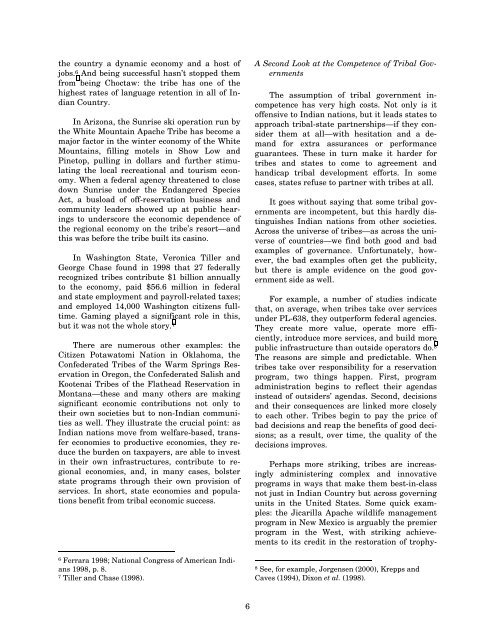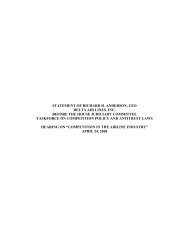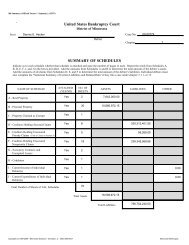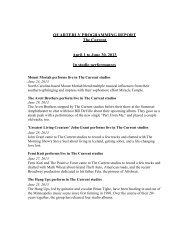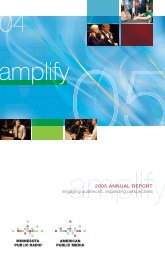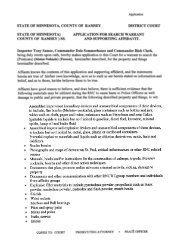Stephen Cornell and Jonathan Taylor - American Public Media
Stephen Cornell and Jonathan Taylor - American Public Media
Stephen Cornell and Jonathan Taylor - American Public Media
Create successful ePaper yourself
Turn your PDF publications into a flip-book with our unique Google optimized e-Paper software.
the country a dynamic economy <strong>and</strong> a host of<br />
jobs. 6 And being successful hasn’t stopped them<br />
from being Choctaw: the tribe has one of the<br />
highest rates of language retention in all of Indian<br />
Country.<br />
In Arizona, the Sunrise ski operation run by<br />
the White Mountain Apache Tribe has become a<br />
major factor in the winter economy of the White<br />
Mountains, filling motels in Show Low <strong>and</strong><br />
Pinetop, pulling in dollars <strong>and</strong> further stimulating<br />
the local recreational <strong>and</strong> tourism economy.<br />
When a federal agency threatened to close<br />
down Sunrise under the Endangered Species<br />
Act, a busload of off-reservation business <strong>and</strong><br />
community leaders showed up at public hearings<br />
to underscore the economic dependence of<br />
the regional economy on the tribe’s resort—<strong>and</strong><br />
this was before the tribe built its casino.<br />
In Washington State, Veronica Tiller <strong>and</strong><br />
George Chase found in 1998 that 27 federally<br />
recognized tribes contribute $1 billion annually<br />
to the economy, paid $56.6 million in federal<br />
<strong>and</strong> state employment <strong>and</strong> payroll-related taxes;<br />
<strong>and</strong> employed 14,000 Washington citizens fulltime.<br />
Gaming played a significant role in this,<br />
but it was not the whole story. 7<br />
There are numerous other examples: the<br />
Citizen Potawatomi Nation in Oklahoma, the<br />
Confederated Tribes of the Warm Springs Reservation<br />
in Oregon, the Confederated Salish <strong>and</strong><br />
Kootenai Tribes of the Flathead Reservation in<br />
Montana—these <strong>and</strong> many others are making<br />
significant economic contributions not only to<br />
their own societies but to non-Indian communities<br />
as well. They illustrate the crucial point: as<br />
Indian nations move from welfare-based, transfer<br />
economies to productive economies, they reduce<br />
the burden on taxpayers, are able to invest<br />
in their own infrastructures, contribute to regional<br />
economies, <strong>and</strong>, in many cases, bolster<br />
state programs through their own provision of<br />
services. In short, state economies <strong>and</strong> populations<br />
benefit from tribal economic success.<br />
6 Ferrara 1998; National Congress of <strong>American</strong> Indians<br />
1998, p. 8.<br />
7 Tiller <strong>and</strong> Chase (1998).<br />
6<br />
A Second Look at the Competence of Tribal Governments<br />
The assumption of tribal government incompetence<br />
has very high costs. Not only is it<br />
offensive to Indian nations, but it leads states to<br />
approach tribal-state partnerships—if they consider<br />
them at all—with hesitation <strong>and</strong> a dem<strong>and</strong><br />
for extra assurances or performance<br />
guarantees. These in turn make it harder for<br />
tribes <strong>and</strong> states to come to agreement <strong>and</strong><br />
h<strong>and</strong>icap tribal development efforts. In some<br />
cases, states refuse to partner with tribes at all.<br />
It goes without saying that some tribal governments<br />
are incompetent, but this hardly distinguishes<br />
Indian nations from other societies.<br />
Across the universe of tribes—as across the universe<br />
of countries—we find both good <strong>and</strong> bad<br />
examples of governance. Unfortunately, however,<br />
the bad examples often get the publicity,<br />
but there is ample evidence on the good government<br />
side as well.<br />
For example, a number of studies indicate<br />
that, on average, when tribes take over services<br />
under PL-638, they outperform federal agencies.<br />
They create more value, operate more efficiently,<br />
introduce more services, <strong>and</strong> build more<br />
public infrastructure than outside operators do. 8<br />
The reasons are simple <strong>and</strong> predictable. When<br />
tribes take over responsibility for a reservation<br />
program, two things happen. First, program<br />
administration begins to reflect their agendas<br />
instead of outsiders’ agendas. Second, decisions<br />
<strong>and</strong> their consequences are linked more closely<br />
to each other. Tribes begin to pay the price of<br />
bad decisions <strong>and</strong> reap the benefits of good decisions;<br />
as a result, over time, the quality of the<br />
decisions improves.<br />
Perhaps more striking, tribes are increasingly<br />
administering complex <strong>and</strong> innovative<br />
programs in ways that make them best-in-class<br />
not just in Indian Country but across governing<br />
units in the United States. Some quick examples:<br />
the Jicarilla Apache wildlife management<br />
program in New Mexico is arguably the premier<br />
program in the West, with striking achievements<br />
to its credit in the restoration of trophy-<br />
8 See, for example, Jorgensen (2000), Krepps <strong>and</strong><br />
Caves (1994), Dixon et al. (1998).


